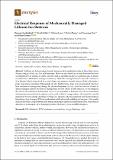| dc.contributor.author | Soudbakhsh, Damoon | |
| dc.contributor.author | Gilaki, Mehdi | |
| dc.contributor.author | Lynch, William | |
| dc.contributor.author | Zhang, Peilin | |
| dc.contributor.author | Choi, Taeyoung | |
| dc.contributor.author | Sahraei, Elham | |
| dc.date.accessioned | 2020-09-01T16:01:42Z | |
| dc.date.available | 2020-09-01T16:01:42Z | |
| dc.date.issued | 2020-08 | |
| dc.date.submitted | 2020-06 | |
| dc.identifier.issn | 1996-1073 | |
| dc.identifier.uri | https://hdl.handle.net/1721.1/126871 | |
| dc.description.abstract | Lithium-ion batteries have found various modern applications due to their high energy density, long cycle life, and low self-discharge. However, increased use of these batteries has been accompanied by an increase in safety concerns, such as spontaneous fires or explosions due to impact or indentation. Mechanical damage to a battery cell is often enough reason to discard it. However, if an Electric Vehicle is involved in a crash, there is no means to visually inspect all the cells inside a pack, sometimes consisting of thousands of cells. Furthermore, there is no documented report on how mechanical damage may change the electrical response of a cell, which in turn can be used to detect damaged cells by the battery management system (BMS). In this research, we investigated the effects of mechanical deformation on electrical responses of Lithium-ion cells to understand what parameters in electrical response can be used to detect damage where cells cannot be visually inspected. We used charge-discharge cycling data, capacity fade measurement, and Electrochemical Impedance Spectroscopy (EIS) in combination with advanced modeling techniques. Our results indicate that many cell parameters may remain unchanged under moderate indentation, which makes detection of a damaged cell a challenging task for the battery pack and BMS designers. | en_US |
| dc.description.sponsorship | Office of Naval Research (grant numbers N000141712869 and N000141912351) | en_US |
| dc.publisher | Multidisciplinary Digital Publishing Institute | en_US |
| dc.relation.isversionof | 10.3390/en13174284 | en_US |
| dc.rights | Creative Commons Attribution | en_US |
| dc.rights.uri | https://creativecommons.org/licenses/by/4.0/ | en_US |
| dc.source | Multidisciplinary Digital Publishing Institute | en_US |
| dc.title | Electrical Response of Mechanically Damaged Lithium-Ion Batteries | en_US |
| dc.type | Article | en_US |
| dc.identifier.citation | Soudbakhsh, Damoon et al. "Electrical Response of Mechanically Damaged Lithium-Ion Batteries." Energies 13, 17 (August 2020): 4284 ©2020 Author(s) | en_US |
| dc.contributor.department | Massachusetts Institute of Technology. Research Laboratory of Electronics | |
| dc.contributor.department | Massachusetts Institute of Technology. Department of Mechanical Engineering | |
| dc.relation.journal | Energies | en_US |
| dc.eprint.version | Final published version | en_US |
| dc.type.uri | http://purl.org/eprint/type/JournalArticle | en_US |
| eprint.status | http://purl.org/eprint/status/PeerReviewed | en_US |
| dc.date.updated | 2020-08-21T13:51:59Z | |
| dspace.date.submission | 2020-08-21T13:51:59Z | |
| mit.journal.volume | 13 | en_US |
| mit.journal.issue | 17 | en_US |
| mit.license | PUBLISHER_CC | |
| mit.metadata.status | Complete | |
